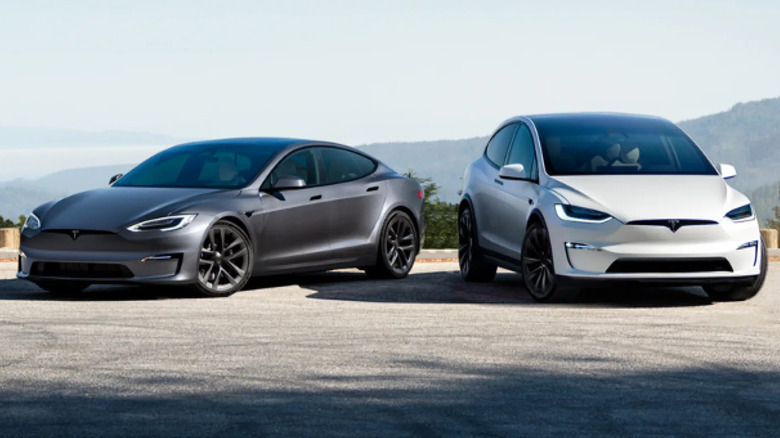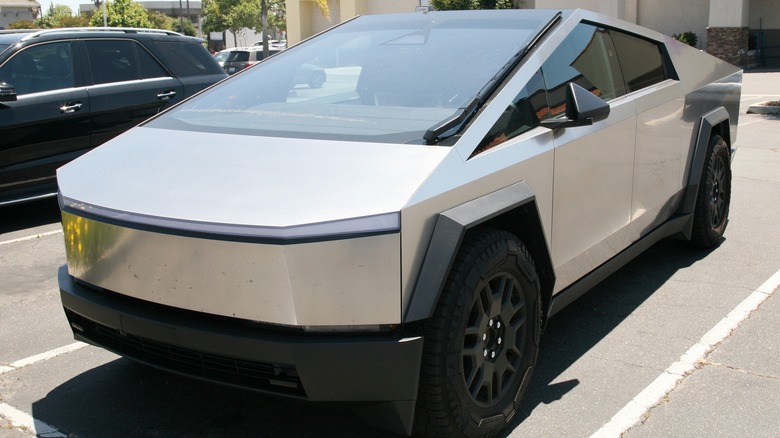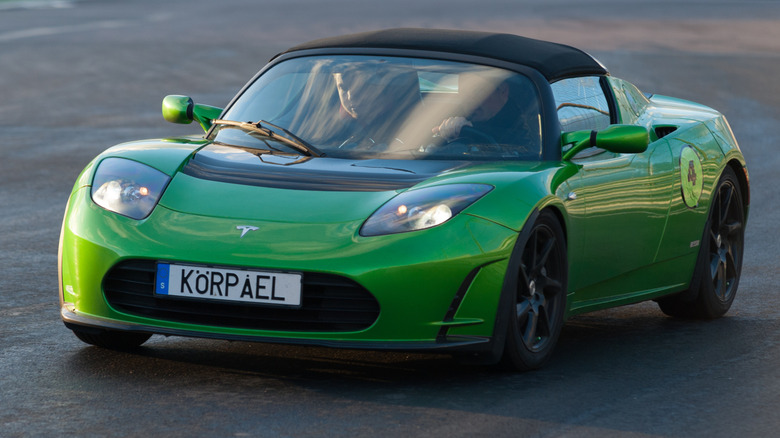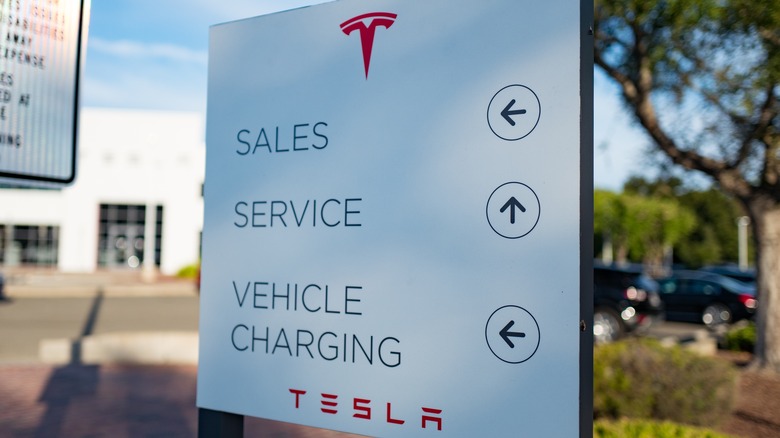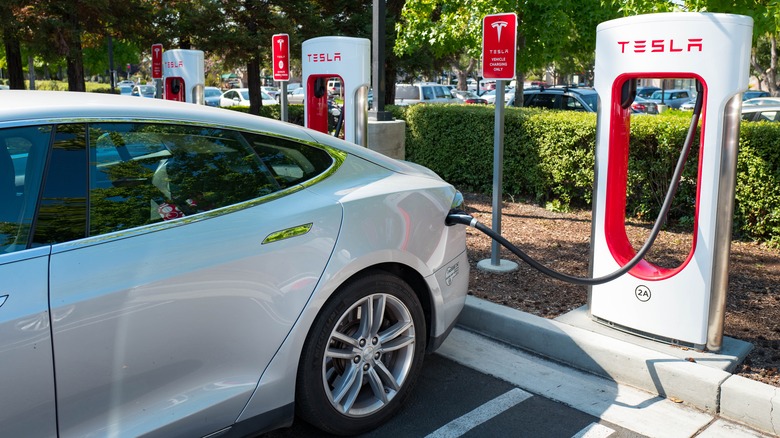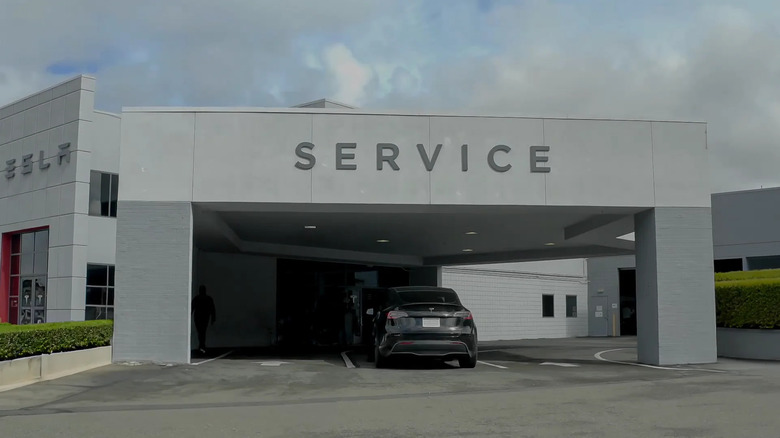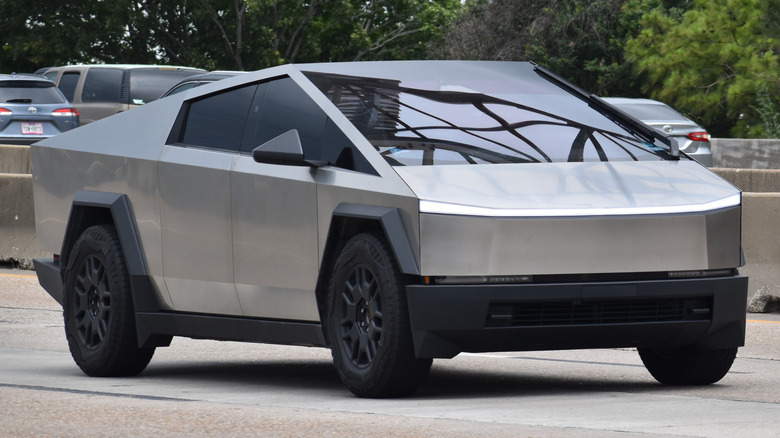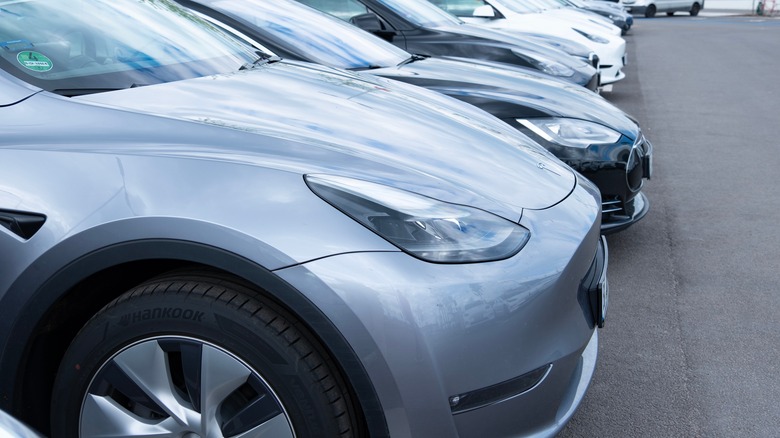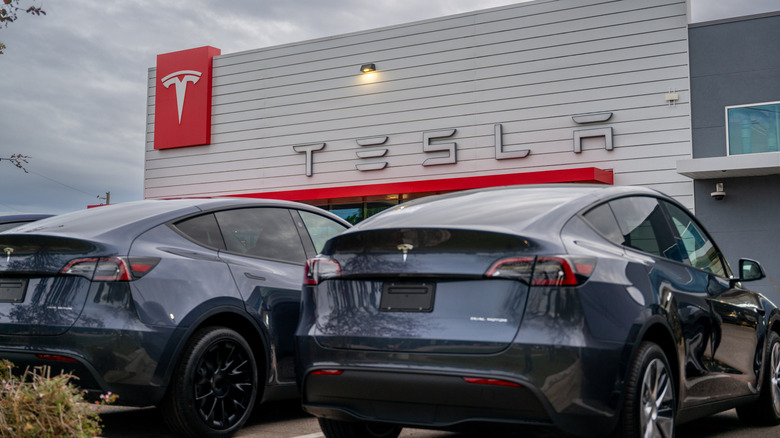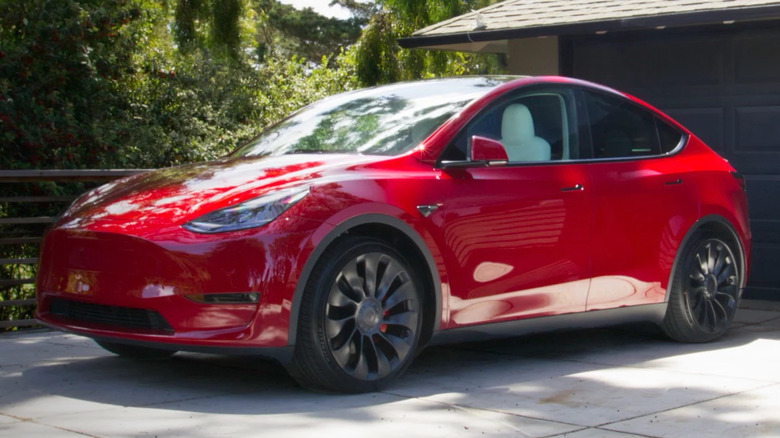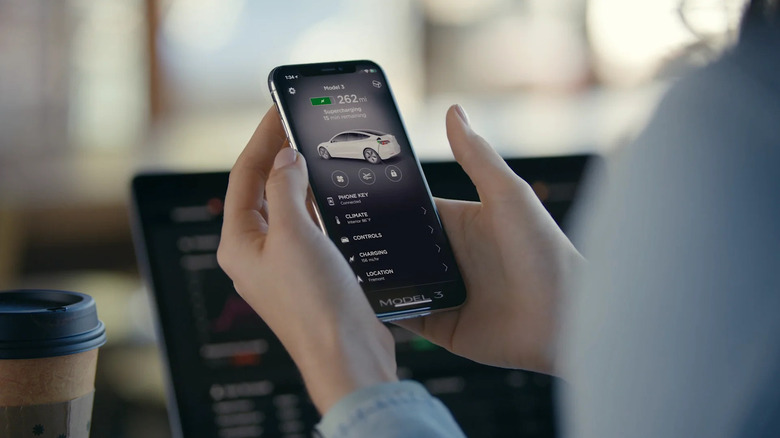10 Things You Should Know Before Buying A Tesla (New Or Used)
Ever since the first Tesla drove onto the scene in 2008, the automobile manufacturer has been turning heads and turning out wallets. From the distinctive look to onboard features like an autopilot system that's the closest to self-driving most of us will get, there's a lot to like about Teslas. There are some downsides, too, however, including how expensive they can be.
Though Teslas started at a higher price point than other electric or hybrid vehicles, prices eventually dropped due to competition. In fact, for 2024, Tesla wasn't the biggest EV seller; that title went to BYD, a Chinese company that produces cars, electronics, and more.
Whatever the price tag these days, driving a Tesla will definitely earn you some attention. Yet there is a lot to consider when shopping for a new or used Tesla. Because prices tend to fluctuate — a fact that CEO Elon Musk says is inevitable due to supply and demand — you'll want to know all the details possible before forking over the cash to drive a Tesla home (or have it delivered).
Recalls might affect new and used Teslas
As of December, Tesla had six Cybertruck recalls in 2024, and other models have had upwards of 20 recalls since their release. For example, the Tesla Model Y has had 22 recalls on the 2020 model year alone. Issues have ranged from muted pedestrian alerts to a lack of alerts when the hood isn't closed to autopilot controls that seem to invite misuse. The 2020 Model Y also had eight manufacturer investigations related to its electrical and other systems.
Most of the recalls on the 2020 Model Y impacted hundreds of thousands — and sometimes millions — of vehicles, so purchasing a used Tesla might pose some risk in terms of recall activity. When shopping for a used Tesla, you'll want to find out whether the particular model has any recalls, and whether it was serviced per Tesla guidelines.
If you're in the market for a brand-new Tesla, there's no risk of pre-existing recalls. Yet a recall could happen at any time, including right after your new Tesla rolls off the lot. For example, various 2024 Teslas, including Models S, 3, X, and Y — plus the Cybertruck — have all had multiple recalls in 2024.
If something feels off, it probably is
It turns out there is a lot that can go wrong with a Tesla, and while plenty of other vehicles have recalls, too, Teslas have made headlines because of significant risks. The bottom line with a Tesla is that if something feels off while you're driving it, there is most likely some kind of issue behind whatever you're noticing.
Teslas have been recalled because of a range of issues, but some of the most dangerous reasons for Tesla recalls involve steering, braking and seat belts. Autopilot overuse/abuse and sticking accelerator pedals also are dangerous and could cause injury.
All this to say that if you plan to buy a new or used Tesla, a test drive will be important, in addition to checking for any recalls. Especially in an older or used Tesla, pay attention to how the car usually handles so you know what "normal" is in case something goes awry.
Consumers can also lodge complaints with the National Highway Traffic Safety Administration, and enough complaints can encourage manufacturers to start an investigation into whatever the issue might be. Given that Elon Musk has very publicly addressed various issues with Tesla vehicles, keeping an eye on his statements could offer insight, too.
Teslas can't be serviced just anywhere
Since Teslas don't have gas engines, there likely many mechanics equipped to service them. Even if your mechanic is willing to help out, they might not be able to, nor is it guaranteed that they can get the necessary parts to fix your vehicle.
Tesla does offer many service centers and even mobile technicians, but you won't be able to roll into any old shop for a quick fix. The automobile manufacturer does offer DIY guides for drivers, but they are limited to things like changing wiper blades and swapping air filters. For more involved work, you'll need to find a service center.
The problem is that Tesla is not able to sell its vehicles in all 50 states (more on that later), which can also affect its ability to open service centers. States that are less friendly toward Tesla are less likely to have a lineup of service centers. Not only that, but in places where Teslas don't sell as much, it's less likely there will be a service center there. While California has tons of service centers, for example, Delaware, Idaho, Hawaii, Louisiana, Mississippi, Rhode Island, South Carolina, and Vermont only have one each. Alabama, Kansas, and Montana are among states with none.
Plus, Tesla states in its purchase agreement that the costs associated with buying a Tesla and moving it across state lines lie with the consumer. We might guess that servicing the vehicle involves the same kind of disclaimer.
A Tesla might be electric, but it's not green
Tesla vehicles offer a gasoline-free way to get around, but that doesn't mean the cars are "green." While Tesla boasts that "Tesla vehicles can travel some of the longest driving ranges of any other production electric vehicle on the market," nixing gasoline is only part of the equation.
Despite plans to become emission-free, Tesla's 2023 greenhouse gas emissions increased by almost 20 percent over the previous year — from a bit below 40 million metric tons to a total of more than 50 million metric tons. The lion's share of that — almost 80% of Tesla's carbon footprint — came from the company's supply chain.
Switching from gas to electric cars does save emissions, with Tesla saying its customers avoided emitting 20 million metric tons of carbon dioxide equivalent in 2023. Plus, traditional vehicle manufacturers have much higher carbon footprints; Ford, for example, had a carbon footprint of 386 million metric tons of carbon dioxide in 2023. Plus, if you're worried about animals, there's no actual leather in a Tesla; Tesla seats are "vegan leather."
Build quality might not be what you expect
When you buy a brand-new Tesla, you might expect amazing build quality. Yet even brand-new Teslas can have problems — like any vehicle — and some models receive more consumer complaints than others. Even a $42,000-plus 2024 Model Y isn't without problems; over 135 consumer complaints plagued the 2024 Model Y before the end of its release year, with a variety of systems being complained about to the NHTSA — everything from failed electrical systems to cars accelerating or braking on their own. Some consumers even reported complete power failures while traveling on freeways, when the vehicle still had a charge.
As far as general complaints, consumers have reported common Tesla Model Y problems with build quality, including noisy on-road experiences. While not every Tesla will have these issues, they are things to be aware of while shopping for a new Tesla or test-driving one, whether new or used.
Although failures can happen in any vehicle, the newer technology in Teslas seems to make more headlines than any other automotive manufacturer's. Other all-electric vehicles like the Hyundai Ioniq, Rivian, or Ford Mustang Mach-E have not had as many recalls or complaints as of December 2024 as the Tesla Model Y.
The Cybertruck isn't entirely bulletproof
When Elon Musk showcased the Cybertruck in 2019 as bulletproof, consumers were skeptical — and even moreso when its "armor glass" window shattered while being tested onstage at a launch event. Multiple tests have shown that the Cybertruck is indeed bulletproof, but only to a certain point.
If you're looking to buy a Tesla, and specifically a Cybertruck, you probably aren't shopping for it solely due to the bulletproof claims. Still, it's worth weighing how trustworthy a car manufacturer's claims are regarding its product's safety and performance. Plus, bulletproof-ness is something of a measure of safety, although crash test ratings are more so.
Apart from defense against bullets, the NHTSA has not crash-tested either Tesla's 2023 or 2024 Cybertrucks at this point. The Insurance Institute for Highway Safety also hasn't tested the Cybertruck, which is the case for a fair number of cars due to limited resources. The NHTSA tests around 86% of new vehicle models, while the IIHS crash tests around 97% of passenger vehicles sold. Still, this might be worrisome for consumers who like to have official (read: non-Tesla) crash data to support their purchasing decisions.
Teslas can't be sold in all 50 states
Technically, you can buy (or at least, take delivery of) a Tesla in any U.S. state, but Tesla is not able to sell them in all 50. While the purchase agreement stipulates that consumers are responsible for taxes and registration regardless of where they buy (or take receipt of) their Tesla, that doesn't mean cross-border sales are simple.
You also can't walk into a showroom to buy a Tesla in many states; the facilities simply don't exist. For example, a 2017 Louisiana law bans manufacturers from selling directly to consumers. While there is a Tesla service center in Louisiana, Tesla unsuccessfully sued the state over the law that prevents the company from selling cars there. Tesla's suit also involved a law that prohibits the company from servicing vehicles under warranty.
Although the ban on Tesla sales in various states seems to have more to do with bureaucracy than problems with the car, it's something to consider whether you're looking for a brand-new Tesla or a used one. If you live in a state where Tesla isn't licensed to sell its vehicles, you'll have to do some traveling to buy — and possibly to maintain — your car.
You may want to skip Tesla insurance
Name another EV manufacturer that offers its own insurance. It turns out there aren't any that do it the way Tesla does, although some companies like Rivian, Ford, and Toyota do have in-house providers.
Tesla offers its own insurance, but it doesn't quite stack up to other providers, according to SlashGear's research. Tesla insurance does use more metrics, including real-time monitoring in states where it's allowed, so you could get more benefits from good driving habits. On the other hand, a couple of poor decisions on the road could cost you, and quickly. Consumers have reported steep increases after their reasonably priced first month.
Also, you can only get Tesla insurance in 12 U.S. states, and Tesla drivers in California don't get the benefit of the real-time monitoring for discounts. Outside of California, which has rules about tracking vehicles, Tesla's usage-based insurance with telematics is the only insurance option with the company.
Monitoring alone might put some drivers off of buying Tesla insurance, but that's not the only insurance issue at play. Plus, it appears to cost more to insure a Tesla than to insure other electric vehicles, even if you skip Tesla's in-house insurance.
There might not be cheap insurance for any Tesla
Insurance can be tricky when you buy a brand-new car, since new vehicles tend to cost more to insure. With Teslas, though, costs are thought to be higher up-front since insurance companies largely consider Teslas luxury vehicles. Prices are around $4,300 per year to insure a Tesla Model S, and $2,600 for a Model Y.
The fact that Teslas can cost quite a bit to repair is also a consideration, with the average repair costing around $5,500. Insurance costs also vary based on the coverage you select, of course, and any discounts your insurer offers. Yet it seems to be agreed on that Teslas are more expensive overall, even if they require less maintenance than cars with a combustion engine. When you do roll into the shop, the fixes will be pricier, which might not impress the insurance companies.
Insuring a Tesla is also more expensive in certain states, such as New York, Michigan, Louisiana, Nevada, and Massachusetts. But regardless of where you live or what Tesla you want to buy, consider getting a few insurance quotes before signing on the dotted line.
Range estimates are just that
When you get into your car to go somewhere, you probably check to make sure you have enough fuel (whether that's gas or electricity) to make it. Imagine if the estimate was so inaccurate that you didn't make it to your destination, and then required a tow or roadside gas service. That could happen to Tesla drivers, according to tests by Car and Driver.
The publication found that Tesla's range estimates were not always accurate, largely because of the way Tesla calculates range. Unlike other EV range estimates, such as the Lucid Air Pure's, Tesla's system apparently doesn't account for changes in terrain or driving habits. Car and Driver said that while EPA range estimates are not entirely reliable either, Tesla's estimated remaining range fell at a consistent rate, regardless of driving habits and the terrain – potentially leaving drivers without enough battery power when they need it the most.
"While Tesla isn't the only automaker that is aggressive with EPA labeling," Car and Driver concluded, "this difference in how its cars estimate the displayed range in the vehicle is at best optimistic and at worst misleading."
